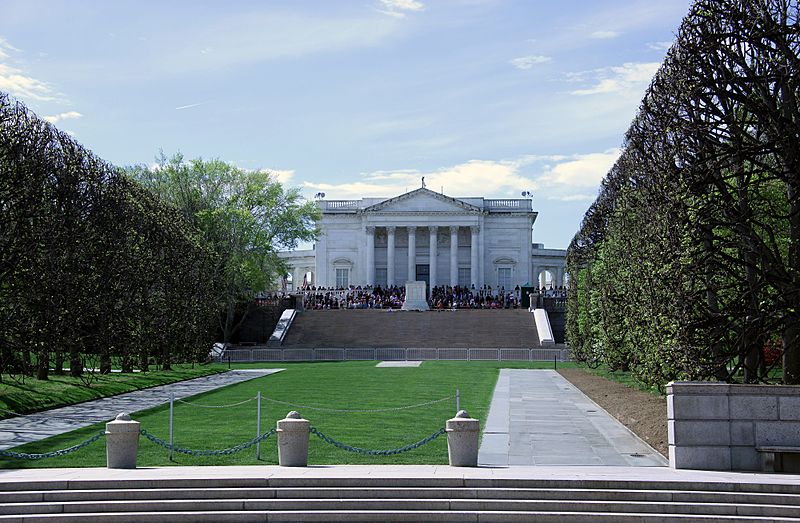Image: Facing W - Quadrangle - Memorial Amphitheater - Arlington National Cemetery - 2012

Description: Looking west across the eastern portion of the quadrangle east of the Tomb of the Unknown Soldier and the Memorial Amphitheater at Arlington National Cemetery near Washington, D.C., in the United States. The Tomb and Memorial Amphitheater can be seen in the distance. Originally, the main entrance to Memorial Amphitheater had a rectangular granite plaza in front of it, from which some short marble steps led down to a slightly elliptical granite plaza surrounded by a marble balustrade. A retaining wall about 20 feet high formed the western end of the "Memorial Park" east of the Amphitheater. In front of the retaining wall, flagstone paths entered from the north and south (the curving paths led back up to the Amphitheater), joining to form a ellipsis with a grassy middle -- which you can see here. (The ellipsis is about 150 feet north-south and 50 feet east-west.) A rectangular grass lawn 50 feet wide extended about 200 feet eastward, ending in a series of short marble steps the led down to Roosevelt Drive. The lawn was bordered on either side with boxwood trees clipped into rectangular shapes. Across Roosevelt Drive was another overlook. This shallow arc contained an Art Deco fountain made of polished bronze. It was anchored on either end with grey granite columns into which were carved by Art Deco eagles. A retaining wall dropped another 15 feet to Section 6 below the overlook. The entire "Memorial Park" was designed to create a formal, Neoclassical space which provided a vista that allowed people standing on the overlooks to see the western end of the National Mall across the Potomac River, and to see the Lincoln Memorial (which began construction in 1914 and was finished in 1922, almost two years to the day after the Memorial Amphitheater was finished). The firm of Carrere & Hastings designed Memorial Amphitheater to have monumental steps leading down to the formal garden from the plaza above. But cost constraints meant that they were not built; only the retaining wall with its false niches and small stairways on either side were constructed. On February 4, 1921, Congress enacted legislation establishing a memorial to the unknown dead of World War I. In October 1921, just a month before the memorial was to be dedicated, it was decided that the new Tomb of the Unknown Soldier should be placed on the steps leading down from the Memorial Amphitheater. In 1926, Congress authorized a memorial to be placed on top of the shaft, which had until then merely been covered by a marble capstone. This cenotaph was placed over the burial shaft in April 1932. Lorimer Rich and Thomas Hudson Jones designed the sarcophagus, and their design (like almost all other submissions) included construction of the monumental steps which had been left out. These steps were authorized by Congress in February 1929, and constructed between 1929 and 1931.
Title: Facing W - Quadrangle - Memorial Amphitheater - Arlington National Cemetery - 2012
Credit: http://www.flickr.com/photos/23165290@N00/7103779089/
Author: Tim Evanson
Usage Terms: Creative Commons Attribution-Share Alike 2.0
License: CC BY-SA 2.0
License Link: http://creativecommons.org/licenses/by-sa/2.0
Attribution Required?: Yes
Image usage
The following page links to this image:

